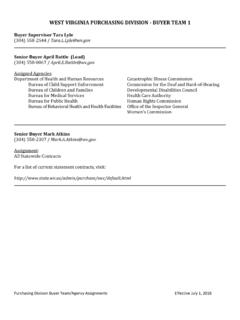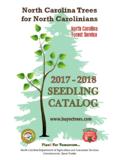Transcription of SPECIES AND COMMUNITIES OF CONCERN IN TENNESSEE
1 Sustainable forestry Practices For Landowners SPECIES AND COMMUNITIES OF CONCERN IN TENNESSEE TENNESSEE is blessed with a rich and diverse landscape. From the soaring Blue Ridge Mountains of east TENNESSEE to the vast Mississippi River Floodplain of west TENNESSEE , this varied landscape provides for a rich and diverse forest. The Sustainable forestry Initiative (SFI) is committed to protecting and managing the quality and distribution of habitats and SPECIES which make-up this landscape. Of particular interest are forests which may be home to a globally rare plant, animal, or community. If a plant, animal, or community is found to be very rare in the world and especially vulnerable to extinction, then it may be classified as critically imperiled (G1) or imperiled (G2).
2 This designation is similar to threatened and endangered designations afforded to SPECIES protected under the Endangered Specie Act (ESA). Typically, critically imperiled and imperiled SPECIES are more rare than SPECIES protected under the ESA. In TENNESSEE there are over 400 SPECIES and COMMUNITIES that are ranked as either G1 or G2 and 58 animal SPECIES and 21 plant SPECIES listed as either federally endangered or threatened. Member companies of the TENNESSEE SFI Program are committed to encouraging landowners, agencies and other groups to identify and protect critical important habitat elements for wildlife, including critically imperiled (G1) and imperiled (G2) SPECIES and COMMUNITIES .
3 Many of these SPECIES are endemic to TENNESSEE , meaning that they occur in TENNESSEE and nowhere else in the world. These and other SPECIES are completely dependent upon good stewardship of our lands, which are also their habitats. The good news is that the conservation of TENNESSEE s biological diversity and good forest management can and do co-exist. Following are some examples of critically imperiled or imperiled SPECIES and COMMUNITIES found in TENNESSEE . TENNESSEE yellow-eyed grass Xris tennesseensis US Fish & Wildlife Photo TENNESSEE yellow-eyed grass is an imperiled specie (G2) found in Alabama, Georgia, and TENNESSEE . It can be found growing in moist to wet soils in association with ferns, willows, buttonbush, and bulrushes in seeps, springs, and on the banks of small streams.
4 Fewer than 20 populations are known to exist. TENNESSEE yellow-eyed grass is very vulnerable to land use conversion and habitat fragmentation resulting from highway construction, drainage, timbering, and fire suppression. During August through September it can be seen flowering with 1 to 2 small, pale yellow flowers. The plant can occur in natural openings and prefers sunlight. Painted tigersnail Anguispira picta Photo by David Ian Withers/ TENNESSEE Natural Heritage Program Painted tigersnail, a strongly depressed, dome shaped land snail with sharp, perfectly smooth, white carina is a critically imperiled SPECIES (G1) located in Crow Creek Valley, TENNESSEE and partially into northern Alabama along the Monteagle limestone outcrops and cliff faces of the escarpment of the Cumberland Plateau.
5 It is estimated that there are 8 population segments mostly on private property. Landowners seem cooperative to conservation efforts, but as some dispose of land the future of the painted tigersnail may be uncertain. Fire is a minor threat to the population. Cumberland Seepage Forest The Cumberland Seepage Forest is a system of primarily forested wetlands which are influenced by natural seepages and are found in the Cumberland Plateau and the Ridge and Valley regions of Alabama, TENNESSEE , West Virginia, and Kentucky. In TENNESSEE it is found on both the northern and southern Cumberland Plateau. These wetlands are found in streamhead swales or on broad sandstone ridges where soils are acidic and saturated due to a perched watertable and/or seepage flow.
6 Most occurrences are from open woodlands to forests, but some may have no forested canopy and be dominated by shrubs or herbs. Characteristic of this system is the presence of sphagnum moss and a dominance of ferns in spots. Commonly found woody SPECIES include red maple (Acer rubrum), black tupelo (Nyssa sylvatica), yellow poplar (Liriodendron tulipifera), sweetgum (Liquidambar styraciflua), American holly (Ilex opaca var. opaca), possum haw viburnum (Viburnum nudum), At risk SPECIES reported for this system include and white fringeless orchid (Platanthera integrilabia) (G2G3). As a good land steward, it s important to be aware of plant and animal SPECIES and ecological COMMUNITIES that are designated as imperiled , critically imperiled , or are threatened and endangered, and how forest management activities on your lands may affect these SPECIES .
7 There are many shining examples across TENNESSEE of private industrial and non-industrial forestland owners managing their forest for both sustainable production and conservation, directly benefiting at risk SPECIES and COMMUNITIES . The TENNESSEE Natural Heritage Program can provide helpful information and assistance on SPECIES of CONCERN in your area. For help, log on to for a variety of resources and information, or call the office at (615) 532-0431. Additional information on SPECIES and COMMUNITIES of CONCERN can be found at the following internet links: NatureServe: National Wildlife Federation: US Fish & Wildlife Service: The Sustainable forestry Initiative (SFI) program ( ) combines the perpetual growing and harvesting of trees with the long-term protection of wildlife, plants, soil and water quality.
8 This information is distributed to you by the TENNESSEE Sustainable forestry Initiative State Implementation Committee and the TENNESSEE forestry Association.





